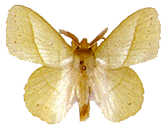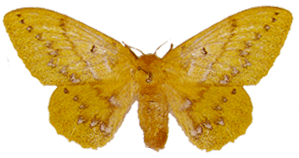|
Trabala
irrorata Moore
Trabala irrorata Moore, 1884, Trans. ent. Soc. Lond., 1884:
375.
Trabala irrorata Moore; Roepke, 1951: 114.
|

Trabala
irrorata ♂
(natural
size)
|

Trabala
irrorata ♀
(natural
size)
|
|

|
Diagnosis. In the male the antemedial of the forewing is obscure; the
postmedial and hindwing fasciae are more or less straight on the upperside,
of yellowish tone; the narrowly darkened fringes are only slightly
crenulate and the submarginal spots are weak with only slight central
'stepping'. Below, the fasciae are again yellow, that of the hindwing
evenly curved. The species is variable with some male specimens having the
area basal to the postmedial of the forewing paler than the ground. The
male genitalia have a distinctive tegumen with a pair of small triangular
processes flanked by two larger ones. The females according to Roepke are
similar to those of the next species, but with less crenulate hindwing
margins; the marginal spots would be less stepped and are acutely angled
basad rather than distad. There is insufficient material to hand to
confirm this; the female illustrated is therefore tentatively associated.
Taxonomic notes. Roepke associated the males discussed here with
the female type, and had in his possession a reared pair enabling him to
associate the sexes correctly. The larger triangular processes of the
tegumen in Bornean males lack the secondary spur of those from Java and
Sumatra.
Geographical range. Sundaland, Mindanao, ?Thailand, ?S. Burma.
Habitat preference. This is the most abundant lowland species in
Borneo, taken in a wide range of forest types including swamp forest. It
is recorded also from lower montane forest, and a pair were taken at about
1500m on Bukit Retak in Brunei.
Biology. Roepke recorded this species as feeding on Ricinus.
Yunus & Ho (1980) noted it from Eugenia, Melastoma, Psidium
and Shorea.
<<Back
>>Forward <<Return
to Contents page |

